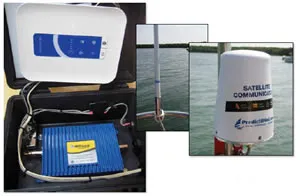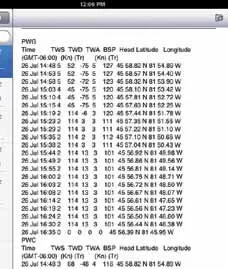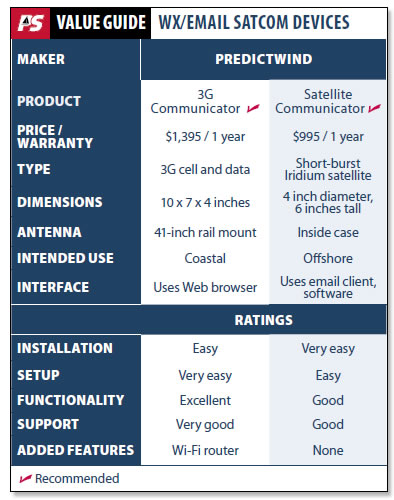
When we reported on Matt Rutherfords solo, non-stop circumnavigation of the Americas aboard his Albin Vega 27 (PS, July 2012), we noted that one of the few electronics that survived his voyage without failing was an email/weather satellite communicator from New Zealand-based PredictWind. Considering the difficulties of the adventure-including transiting the Northwest Passage through the Arctic and rounding Cape Horn, in all types of conditions, aboard a wet boat-we considered this high praise for an electronic device and decided a Practical Sailor sea-trial was in order.
PredictWind is primarily a weather-forecasting company-not an electronics manufacturer-that got its start in 2000, when founder Jon Bilger began developing tailored weather forecasts for Americas Cup racing. Over the years, the company developed a number of weather forecasting products and related electronics that enabled clients to receive its weather forecasts beyond the range of typical Internet and cellular signals.
For our sea trial, the company supplied us with its PredictWind Satellite Communicator and its newest product, a 3G Communicator, which is basically a modem/booster for 3G cellular signals.
What We Tested
PredictWinds offerings include high-resolution wind predictions for more than 20,000 locations throughout the world. Since 2008, the company has offered free wind predictions for recreational and racing sailors through its website. They also offer higher-resolution and more accurate forecasts for a fee, along with services like weather routing, trip planning, boat tracking, live observations, and forecast alerts. The forecasting model has proven successful and the predictions accurate-especially for long-distance sailors like Rutherford and offshore racers like Volvo Ocean Race crews.
PredictWind website users can get free single-day forecasts, but in-depth forecasts require a subscription. Annual subscription rates range from $19 for a basic package (five-day forecasts with high-resolution, which is adequate for the casual, coastal cruiser) to $499 for the professional package, which includes personalized weather forecasts plus weather routing, trip planning, location reporting, alerts, and high-resolution GRIB downloads. To get weather routing updates via the Satellite Communicator, the professional package is required.
We tested the PredictWind Satellite Communicator and 3G Communicator, which were developed to extend the geographic range at which sailors can receive the companys weather forecast services. Both are available only through the company website.
Built by Canadian company Joubeh Technologies, the Satellite Communicator will be of most interest to long-distance sailors who can receive the forecasts by satellite email. In addition to enabling users to receive the forecasts from PredictWind, the device also allows them to send and receive short emails- similar to other Satcom devices like the Cerberus (also reviewed in this issue). It does not offer users Internet access.
Made in New Zealand, the 3G Communicator will appeal to near-coastal cruisers in areas where 3G cell-phone and data coverage are available, but not necessarily close by or dependable. The device is basically a modem with a signal booster for 3G cell and data service, plus an onboard router.
The company also has Android and iPhone apps that are usable when you are connected to a Wi-Fi or 3G cell network. The apps, in effect, duplicate all of the website features and add tracking functionality.
How We Tested
Practical Sailor testers put Predict-Winds weather services and electronics through their paces during a three-month summer cruise aboard a Niagara 35 on Lake Huron in the Great Lakes.
We used the devices to send and receive emails and weather forecasts, and testers evaluated the accuracy of the forecasts, as well as the functionality of other features like trip planning and weather routing.
Weather Service / Website
PredictWinds forecasts are generated twice a day, and in most regions, a new forecast is available each morning and night. Subscribers can get their forecast in one of four coverage resolutions: 100 kilometers, 60 kilometers, 8 kilometers, and 1 kilometer. Most weather websites use only the 60-kilometer resolution.
PredictWinds forecasting begins like that of most other commercial weather services: Observational weather data is submitted to the World Meteorological Organization (WMO), and then various governmental organizations create observation files (akin to a photograph of the earths atmosphere); from these files, weather models are developed. According to PredictWinds Bilger, the company is the only non-governmental organization to run observation files from the Global Forecast System (GFS) and Canadian Met Centre (CMC) models on its own global weather model. Most other forecasting services simply use the GFS.
PredictWinds forecasts include wind speed and direction, wave height, period and direction, as well as temperatures, rainfall, and cloud cover. Using the website, users can view the forecasts in several graphic and table formats, including isobar maps, GRIB files, and contour maps. For those away from Wi-Fi and cell service, PredictWind will deliver the forecasts and weather routes in a text format via satellite email. Subscribers also can have these sent as GPX files (compatible with a range of navigation software) or KML files (to be overlaid on Google Maps).
Website tools include weather-routing, trip-planning, boat-tracking, and forecast alerts. Weather routing, for example, lets you set beginning and end locations and intermediate waypoints for a passage. Users also can customize settings; for example, whether youre more interested in speed or comfort, and maximum wind and wave conditions that you want to experience.
Bottom line: The weather predictions were very accurate during our sea trials. While existing free services were adequate for our short-hop cruising on the Great Lakes, PredictWind would offer a much bigger advantage for offshore sailors and coastal cruisers on longer trips.
Satellite Communicator
The Satellite Communicator measures 4 inches in diameter and 6 inches tall. It is well-sealed against weather with only a sealed power cable entering the housing. Its beefy, weatherproof construction most likely accounts for the dependability and durability that Rutherford experienced with it during his extreme voyage.
The unit can accept a voltage range of 10 to 30 volts DC. We tested at 12-volts and found its power draw to be minimal-an average of about five-tenths of an amp-so low that we left the test unit turned on at all times during the three-month cruise.
Inside the housing are a GPS, a satellite modem transmitter/receiver, and a wireless transmitter/receiver to network with a computer. The wireless transmitter is a new design feature; the earlier model that Rutherford used featured a wired connection to a computer.
The Satellite Communicator comes with software to retrieve and send regular emails through a PredictWind email account; however, no attachments can be received, and the emails are broken into chunks of 160 characters. Since the device has a GPS, position updates also can be sent through the satellite communicator-similar to the position updates sent by the SPOT Connect and Cerberus reviewed in this issue.

Unless you plan to have Internet access where youre sailing, its essential to set up the service on the PredictWind website before setting sail. The site lets you select or create your own polar curve, a representation of your boats performance in various wind speeds or headings, and customize your preferences (speed, comfort, etc.). Upon departure, you then just switch on the automatic email weather-routing updates.
To deliver the emails and updates, the Satellite Communicator uses the Iridium 9602 modem and short-burst data service, a robust and relatively inexpensive system. Although the system can handle long text emails, it will not accept attachments, and, of course, there is no voice communication.
Forecasts and weather route info come in text email format via the Satellite Communicator, but GRIB files cannot be transmitted. However, subscribers can have the PredictWind forecast overlaid on Google Earth maps as a KML file; this is done automatically using the email client. A GPX file is also generated, and that can be overlaid on most navigational software, including iNavX.
The advantage of the system is that the weather routing is happening on our servers with the highest resolution and most detailed forecasts for wind, swell, and ocean currents, Bilger said. Then the weather route (track and weather) data is automatically transmitted as soon as the forecast is produced.
So theres no need to install routing software, download multiple GRIB files, and then run and interpret the results, Bilger said. Essentially, PredictWind does the work for you and sends the results.
The Satellite Communicator costs $995, which is pricey but less expensive than other satellite systems hardware, such as the Iridium 9575 handset, the IsatPhone Pro, and the FleetBroadband Inmarsat.
Its important to pay attention to the data usage pricing when shopping for a Satcom device. Like most manufacturers of devices that use a satellite network, PredictWind buys Iridium data at wholesale and resells it. Its monthly charges and data costs for the Satellite Communicator compare favorably to similar sat services like Yellowbrick tracking (www.yellowbrick-tracking.com): Weather routing for a six-day route runs $5; $20 per month covers all tracking costs; routes/emails are $1.70 per kilobyte (kB), which works out to about $2.50 for a three-day route.
According to Bilger, most customer bills run in the $30-$100 per month range. To contain data usage charges, we recommend giving only family and select friends the associated email address, and request that they keep their emails brief. Users can check data usage at any time through the email client.
Bottom line: If you want a high-quality, accurate weather and routing service as well as basic email capability while you are sailing offshore, this is a reasonably priced solution. The PredictWind Satellite Communicator is easy to use, draws little power, and is very well built. Its bulletproof construction has proven itself in extreme conditions, and testers had no major complaints about it during our three-month sea trial. Rutherford gave it an A after his non-stop Around the Americas voyage, and we second his opinion.
3G Communicator
The 3G Communicator is a 3G modem with a signal booster for 3G cell phone and data service. The unit comprises a dual-band signal booster made by Wilson Electrics and a Globesurfer 3G modem, which incorporates a Wi-Fi router for on-board use. The device comes with a marine antenna, a phone handset, a waterproof Pelican carrying case, and the necessary, pre-wired 12-volt and antenna cables.
To use the device, you need a cell-providers SIM card and a voice and data plan from a cellular provider. We used a Rogers Communications SIM card and pre-paid plan in Canada, and it worked well.
PredictWind claims the device offers a 3G range of 50 nautical miles. While we could not verify that claim during our coastal test cruise, the unit repeatedly provided a usable 3G signal when our two on-board 3G cell phones and two 3G iPads had no signal at all. We mounted the antenna on the boats pushpit, but we could have gotten an even better range had we mounted the antenna higher.
You can access the Wi-Fi/3G modem software, instructions, and other features through a Web browser. There, you also can access SMS messages on your SIM card, check signal strength, etc.
With the 3G Communicator operating, we had phone service and were able to get email and surf the Internet on both iPads and two on-board computers through the devices Wi-Fi, using the data plan.
Power draw (at 12 volts) averaged about a half-amp while the device was operating. We left the 3G Communicator turned off when we werent using it, mostly because we were using a pre-paid cellular data plan, and we didnt want unexpected browser updates and downloads wasting our available data. We turned it on only to check email, visit the PredictWind and other weather websites, and to do some Internet searching. The power draw is minimal, so users with unlimited data plans could leave the unit on all the time without worry.
The 3G Communicator retails for $1,395, not including the requisite 3G voice and data plan. This is considerably more expensive than the antenna-style Wi-Fi booster systems weve tested (PS, November 2010)-the Wave Wi-Fi Rogue Wave ($400), the BitStorm Bad Boy Xtreme ($210), and The Wirie ($250). However, none of those products offered 3G connectivity when we tested them, none offered a comparable extended Wi-Fi range, and none came with all the hardware that accompanies the PredictWind 3G Communicator.
Bottom line: The 3G Communicator is a well-thought-out, high-quality device. Its biggest drawback is its price, and its value is subjective. Coastal cruisers will have to weigh the cost with the importance of having a reliable Internet connection when away from shore.
Conclusion
Testers noted that both PredictWind Satcom devices were well-made and undoubtedly would perform well in the marine environment. Both worked well during field tests, and testers had few complaints. The Satellite Communicators record in harsh conditions during Rutherfords voyage is a testament to its durability.
There are few devices that offer the weather forecasting services of Predict-Wind plus email and tracking capability. However, there are plenty of cheaper options for weather data and updates, although they may not be of the same quality and the text or GRIB formats may be challenging for some sailors to interpret.
Budget cruisers might prefer a single-side-band (SSB) transceiver for receiving weather forecasts, but buying and installing an SSB can be quite pricey-not to mention they are fussy to set up and keep working at sea. Other options include using SailMail (www.sailmail.com) to receive free text or GRIB weather forecasts via SailDocs.com, or by requesting free forecasts directly from the U.S. National Weather Service.
Several other commercial services format and email text forecasts, suggested routes, and GRIB files for a fee, among them BuoyWeather, Ocens, MaxSea, MovingWeather, and Mto-France. Cruisers also can use SailMail to communicate with a meteorologist or commercial weather service who can advise on reasonable departure dates and routes, and can send periodic routing advice during a passage. (SailMail.com has a list of meteorologists and commercial weather services.)
New bluewater cruisers who are unsure of their weather interpreting ability, and those desiring the email and tracking capability of a Satcom device would do well to consider the PredictWind Satellite Communicator.
As for the 3G Communicator, we would definitely recommend it for cruisers who rely on an Internet connection to work regularly from their boat-based office. Beyond that, it comes down to determining whether it fits your budget and needs, and whether it would be useful in your cruising area. A good portion of the U.S. coastline has 3G coverage within range of a smartphone or iPad, but there are long stretches with no coverage at all. If you tend to cruise 25 to 50 miles offshore, the PredictWind 3G device is a good choice; if you tend to stick inside the 5 to 10-mile range, consider checking out a Wi-Fi antenna booster like those we tested in 2010 and updated in the January 2011 issue.






































